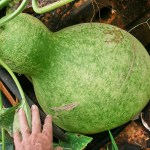gene flow
Science Magazine this week published the winners of this year's International Science and Engineering Visualization Challenge.
Self-Fertilization: Heiti Paves and Birger Ilau, Tallinn University of Technology
Within its tiny white flowers, thale cress (Arabidopsis thaliana) does what most plants avoid: It fertilizes itself. Heiti Paves of Tallinn University of Technology in Estonia took this photograph of the flower with its pollen grains and ovaries stained blue to show the process in action. From the six pollen heads, the grains grow thin tubes toward the bean-shaped ovaries in the flower…
One of the more substantive consequences of the powerful new genomic techniques has been in the area of ancient DNA extraction and analysis. The Neandertal genome story is arguably the sexiest, but closer to the present day there've been plenty of results which have changed the way we look at the past. The input of genetics has basically demanded a revision of the contemporary consensus of the origins of the Etruscans which emerged from archaeology. Though certainly ancestry and genetic relationship are informative, ancient DNA has also given us windows into the change of function and a…
When it comes to plants, there can be no gene flow without two compatible partners. And most plants are quite choosy, preferring a close relative rather than someone outside its family. Pollen travels in gusts of wind, on the pollen basket of bees, as cargo of flies or in the hands of human plant breeders. If the pollen alights upon a compatible mate, there will be fertilization and the resulting seed will carry the genes of the parents. What will happen then if a transgene from a genetically engineered crop plant cross-pollinates with wild relatives?
A new study in PNAS suggests that we…

